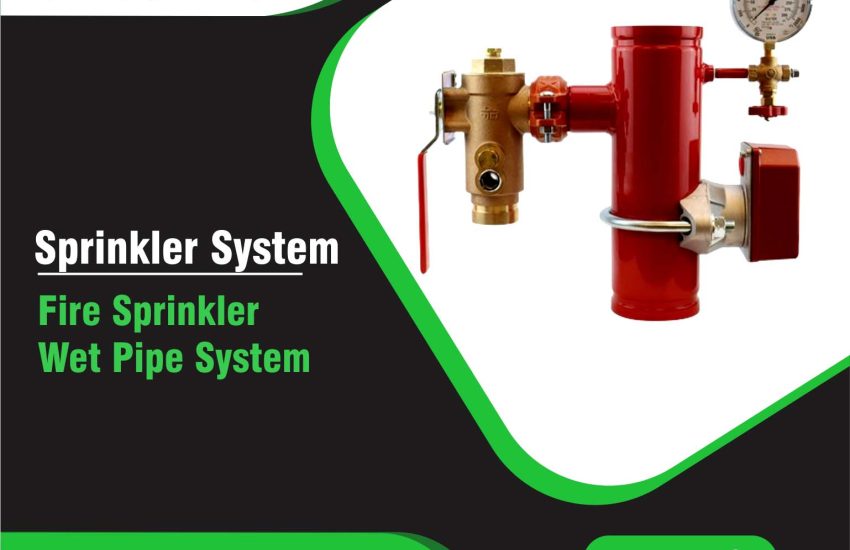Fire Sprinkler Wet Pipe System is a common and effective solution for fire protection in buildings. It quickly controls and suppresses fires, reducing damage and enhancing safety. Understanding the system’s specifications, components, and benefits is essential for architects, builders, and safety professionals.
What is a Fire Sprinkler Wet Pipe System?
The Wet Pipe System is an automatic fire sprinkler system. In this system, pipes are always filled with water. When a fire occurs, heat activates the sprinkler heads. This releases water directly onto the fire, suppressing it efficiently. The Wet Pipe System helps control fires early, providing more time for evacuation and reducing property damage.
Key Specifications of a Wet Pipe System
Pipe Material
Wet pipe systems use various materials such as steel, copper, or CPVC (chlorinated polyvinyl chloride). Steel is typical for commercial and industrial buildings. CPVC is commonly used in residential settings due to its light weight and corrosion resistance.
Water Supply
The system connects to a reliable water supply. This ensures continuous water availability during a fire. The water source is often a municipal water line or a dedicated fire pump.
Sprinkler Heads
Sprinkler heads in a Wet Pipe System activate at a specific temperature. The typical activation temperature is 155°F (68°C), although some systems use 165°F (74°C). The sprinkler head’s glass bulb or fusible link breaks when exposed to heat, releasing water.
Activation Mechanism
Each sprinkler head activates individually based on the temperature. Once a head activates, water is released to extinguish the fire at the source. This minimizes water wastage and directs it only to the affected areas.
System Components
The key components of a Wet Pipe System include:
- Control Valve: Regulates water flow into the system.
- Alarm Valve: Signals when the system is in use or compromised.
- Pipe Network: Carries water from the main supply to the sprinkler heads.
- Sprinkler Heads: Release water when the set temperature is reached.
Pressure Rating
The Wet Pipe System typically operates at pressures between 7-10 bar (100-150 psi), depending on the building size and requirements. Taller buildings or larger areas may require higher pressure for sufficient coverage.
Flow Rate
Flow rates vary based on the number of sprinkler heads and the level of fire risk. For a standard Wet Pipe System, the flow rate ranges from 10-100 gallons per minute (GPM). This ensures enough water reaches the fire to suppress it effectively.
Maintenance
Regular maintenance is essential for the Wet Pipe System. Routine inspections ensure that the control valve works properly, the sprinkler heads are clear of obstructions, and the water supply is secure. Proper upkeep enhances system reliability and ensures proper function during emergencies.
Benefits of a Wet Pipe System
Reliable Fire Protection
Wet Pipe Systems are known for their dependability. They are always ready to respond when a fire occurs. Since the pipes remain filled with water, the system activates quickly, providing immediate fire suppression.
Cost-Effective
The Wet Pipe System is simple, making it affordable to install and maintain. It does not require complex mechanisms or chemicals, offering a cost-effective solution for both residential and commercial buildings.
Minimal Water Damage
This system limits water damage. It only activates the sprinklers near the fire, which helps reduce flooding in unaffected areas. The controlled water application prevents unnecessary damage.
Automation and Ease of Use
Wet Pipe Systems operate automatically. Once installed, they require minimal intervention. This automation provides peace of mind, knowing that the system will activate without human action during a fire.
Compatibility with Various Buildings
Wet Pipe Systems are versatile. They work well in residential homes, office buildings, hospitals, shopping malls, and industrial warehouses. This system is ideal for buildings with predictable fire risks.
Applications of Wet Pipe Systems
Wet Pipe Systems are used in a wide range of settings, such as:
- Residential Homes: To ensure fire protection for families.
- Office Buildings: Protecting employees and office spaces.
- Hospitals: Safeguarding healthcare facilities.
- Retail Centers: Protecting shopping malls and stores.
- Warehouses and Factories: Mitigating fire risks in industrial environments.
Conclusion
The Fire Sprinkler Wet Pipe System is a reliable and efficient fire protection solution. Its simple design, ease of maintenance, and quick response make it an excellent choice for various buildings. By selecting the right materials, water supply, and pressure specifications, the system can be tailored to meet specific fire safety needs. Regular inspections ensure that the system functions correctly when needed most. For anyone seeking an effective fire protection solution, the Wet Pipe System offers an affordable and dependable choice.


